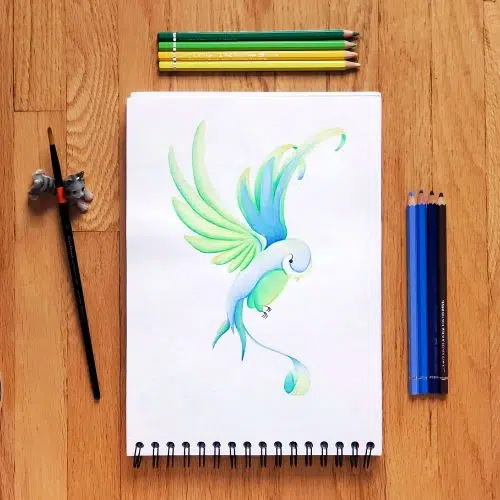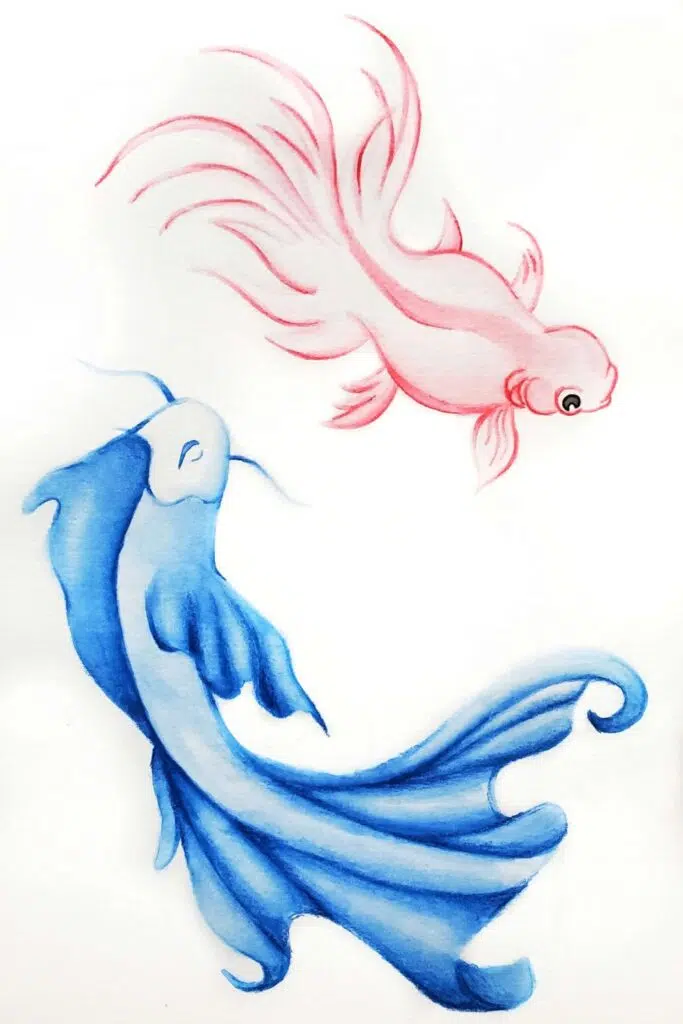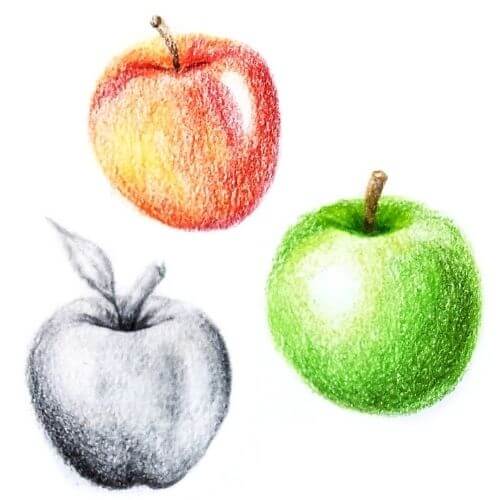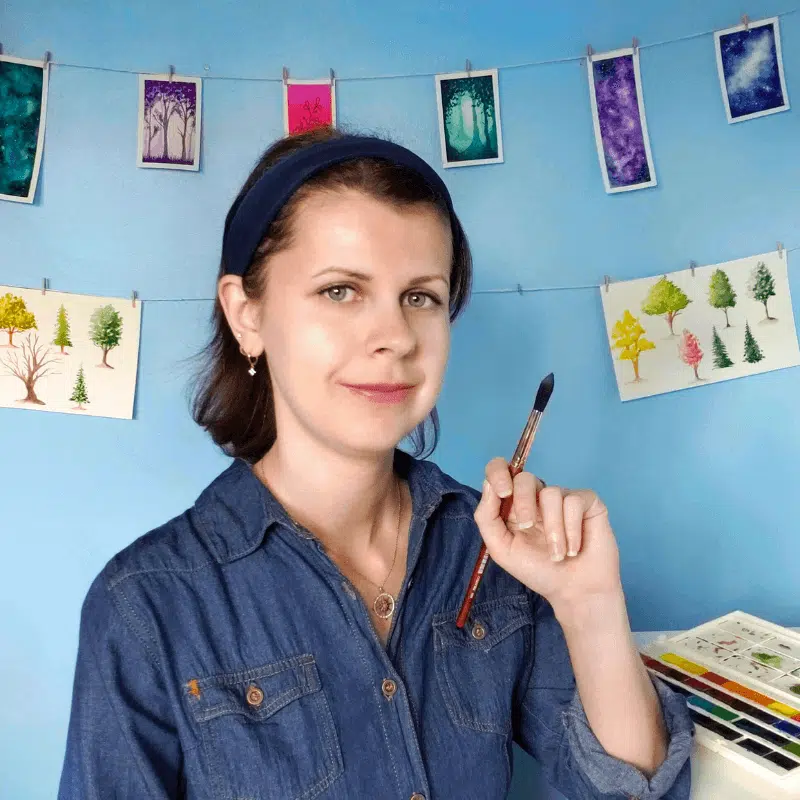Did you know that you can paint with watercolour pencils instead of pans and tubes?
It’s true!
Watercolour pencils are unique because they combine the best aspects of painting and drawing.
So, you wonder, How do you use watercolour pencils?
I’m glad you asked because in today’s article, I’m taking the time to highlight:
- The differences between watercolour pencils vs coloured pencils and how they differ from pans and tubes
- Techniques and strategies to help you paint with water-soluble pencils
- The best, affordable watercolour pencil brands you should invest in
By the time you’re done reading, you’ll understand how to apply watercolour pencils in both their wet and dry formats.
DISCLOSURE: This page contains affiliate links. If you make a qualified purchase using any of the links, I’ll earn a small commission at no extra cost to you. I appreciate every sale because it allows me to create free content to promote the growth of this website.
Table of Contents
Why Use Watercolour Pencils?
Watercolour pencils differ from traditional watercolours because the unique ergonomic shape of the pencil allows you to switch between painting and drawing.
As such, you can add water to activate the pigment or you can simply lay down pigment in the same manner as one would apply a coloured pencil without adding water.
As you can see, watercolour pencils offer more versatility than regular watercolour paints.

As well, due to the ergonomic design of the pencil, you may find it easier to control the pigment.
This means it’s easier to create precise details with the pencil tip and the learning curve isn’t as steep since you don’t have to learn how to manipulate the bristles of a paintbrush.
Another advantage of watercolour pencils is that they’re less messy. Why? Because it takes less water to activate the pigment.
This means that learning how to use watercolours is actually easier and less of a hassle than you may think.
As a result, you may find it easier to conduct plein air painting outside or to create artwork on the go.
Are Watercolour Pencils the Same as Coloured Pencils?
At some point, you might have wondered, “What is the difference between watercolour pencils and regular pencils?”
First of all, it’s important to note that watercolour pencils should not be confused with coloured pencils despite their similar appearance.
Here are several characteristics that highlight water-soluble pencils:
- Watercolour pencils have pigment that is activated when water is added to it. By doing so, these pencils can create similar effects to traditional watercolours
- Watercolour pencils can be used as both a wet and dry medium which gives you more versatility
- Watercolour pencils can be layered just like coloured pencils, although the application techniques differ
Now that you understand the differences between watercolour pencils vs coloured pencils, let’s have a look at how you can use these pencils in your artwork.

How Do You Use Watercolour Pencils?
Watercolour pencils are easy to use for beginner artists.
In fact, watercolour artists who can draw are at an advantage because coloured pencils and watercolour pencils have many similar applications and techniques.
However, watercolour pencils are ultimately different from traditional watercolour pans and tubes, so you need to learn the best practices for this medium.
First, like any medium, you should create a swatch chart to test each pencil’s pigments. Then you can use it as a reference chart when you begin painting.
Second, experiment by drawing with the watercolour pencils in the same manner that you would apply coloured pencils. Start off lightly and then build up the layers by working light to dark.
Once you’re satisfied with the layers, apply water to the pigment to activate it. Use your paintbrush to distribute the pigment to create lovely washes.
Note: Check out this educational article for more useful watercolour tips and tricks.
Last, learn how to apply the pigment without creating obvious pencil marks. After all, you don’t want harsh lines of pigment to show through the transparent watercolour layers.
To achieve this, you must apply the pigment gently. If you put too much pressure on the pencil, the pigment will dig into the paper, thus making it hard to blend the pencil marks away.
Watercolour Pencil Techniques
In this section, you’ll explore the best techniques that you can use to get the most out of your water-soluble pencils.
In addition, you’ll get to compare and contrast how these techniques differ from the best watercolour techniques and practices that you would use when using traditional watercolour paints.
1. Can Watercolour Pencils Be Used Dry?
Yes, watercolour pencils can be used dry. After all, it’s this unique versatility that makes these pencils so desirable for artists.
In order to apply the pencils dryly, lay down the pigment in the same manner as you would apply coloured pencils.
That means you can colour, shade, cross hatch, and outline your drawing by using the sharp tip of the pencil.
What’s more, you can apply dry watercolour pigment on top of traditional watercolours that have already dried.
This method gives you more control and precision over the vibrancy of the colours.

2. Applying Light and Hard Pressure
When using watercolour pencils, it’s important to understand how pressure affects the intensity of the colours.
For example, applying light pressure to the pencil means the pigment will appear lighter on the paper. When you apply water, the colour will look more muted and less pigmented.
Conversely, if you apply heavier pressure, the pigment will appear darker and more vibrant.
Using this knowledge, it’s up to you to decide how much pressure you will put on your pencil in order to achieve your desired vibrancy.
3. How to Activate Watercolour Pencils
Remember that, unlike traditional watercolours, watercolour pencils don’t require as much water to activate the pigment.
So, you’ll have to practice to figure out the best water to paint ratio for your pencils.
With that being said, here is a short list that describes common techniques you can use to activate the pigment with water:
- Draw on the paper first and then apply water to the pigment. You can lay down a few colours next to each other and then blend them together to create a variegated wash
- You can dampen the paper using the wet-on-wet technique and then draw directly onto the wettened paper
- You can lay down all the colours at once—including all shading—and then blend the colours using a damp brush. Or you can work in layers to achieve the same result. The choice is yours
Experiment with each of these techniques to discover which forms of application suit your personal artistic style the best.
Which Watercolour Pencils Are the Best?
If you purchase a set of water-soluble pencils, you want the best watercolour pencils that are affordable and of high-quality.
For this reason, I’m sharing with you several watercolour pencil brands that I highly recommend.
1. Faber-Castell Albrecht Dürer Watercolour Pencils
If you’re wondering what is the best pencil to use for watercolour, I recommend this set of Faber-Castell watercolour pencils.
Every pencil has a unique ergonomic shape that fits comfortably in your hand. The lead is strong and break-resistant, so you don’t have to worry about the pencils breaking randomly.
Each pencil has a smooth application which makes them easy to handle for beginners and professionals alike.
What’s more, this quality makes the pigment easy to lay down, blend, and layer. For example, you can easily create soft, delicate watercolour washes or bold, vibrant linework.
Faber-Castell Watercolour Pencils
• 24 vibrant watercolour pencils in a wide range of colours
• These dynamic pencils can be used either wet or dry
• Pigments lay down smoothly and are easy to layer or blend
BUY ON AMAZONConclusion
Final verdict: Are watercolor pencils worth it?
Absolutely!
As you’ve learned, watercolour pencils are flexible and versatile art supplies that appeal to many individuals whether they be beginners or experienced artists.
Their ability to be used in both a wet and dry format makes them very ideal for artists who value versatility in their artwork, such as people who are skilled in both painting and drawing.
Furthermore, the tidy and portable nature of watercolour pencils makes them ideal for painting on the go.
Do you enjoy painting and drawing with watercolour pencils? Share your thoughts in the comments below!

Miranda Balogh
Artist & Online Educator






Can you use water colour pencils on dampened or set water color paper as you can with regular watercolor paints?
Hi Jane! You can use watercolour pencils on dry or damp paper. Personally, I prefer to lay down the pigments with the pencils on dry paper and then add water to blend the pigments together because I find this method easier. However, you could experiment with the second option by laying down the water first and then using the watercolour pencil of top of the damp paper. Keep in mind that the paper can’t be too wet for this option to work. So give both methods a try to see which one suits your painting process better!
What kind of watercolor paper would you use? Hot or cold press?
Hi Camille! You can use either paper. In a nutshell, cold-pressed paper is more textured whereas hot-pressed paper is smoother. On one hand, cold-pressed paper is easy to work with and the pigments dry vibrantly. On the other hand, watercolour pencils lay down smoothly on hot-pressed paper, but they don’t dry as vibrantly. The best thing to do is to experiment with both types of paper to decide which one better suits your style and painting process!
As a professional for thirty plus years, and watercolor pencils my preferred method,, I must comment. NEVER PLACE THE PENCIL DIRECTLY IN WATER. Moisture will migrate up into the shaft and ruin the pencil.
Thank you for sharing the information! I’ve updated the article to reflect this point.
Can you point me to which article that is please?
I am at a loss as how to effectively add water to my pencil drawings.
– a newbie
Hi William! Can you be more specific in terms of which article you’re looking for? Let me know!
Do you think CaranD’ache supracolor pencils are good? What about Derwent Inktense ?